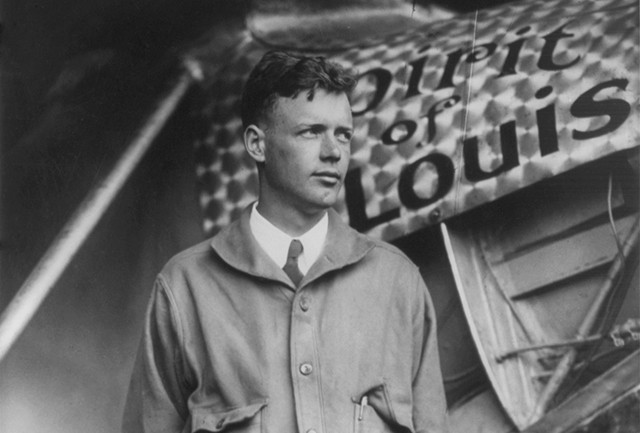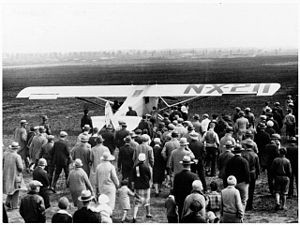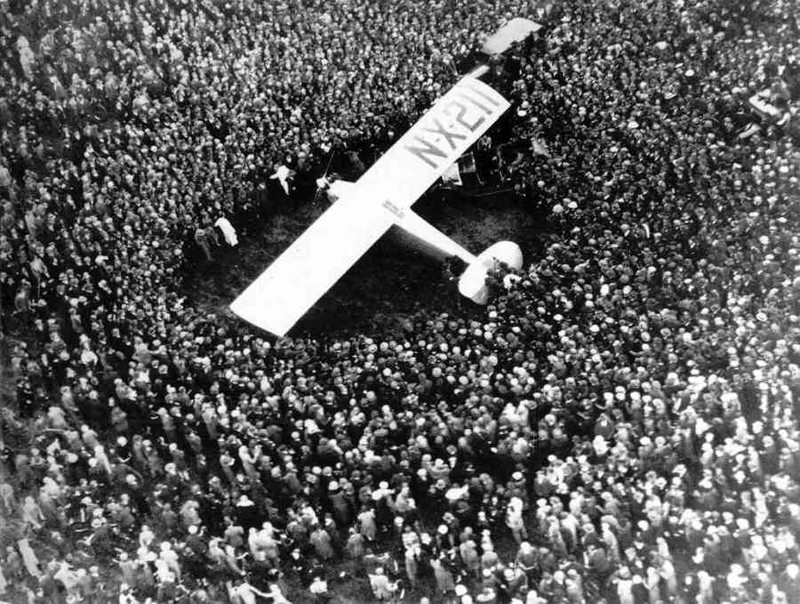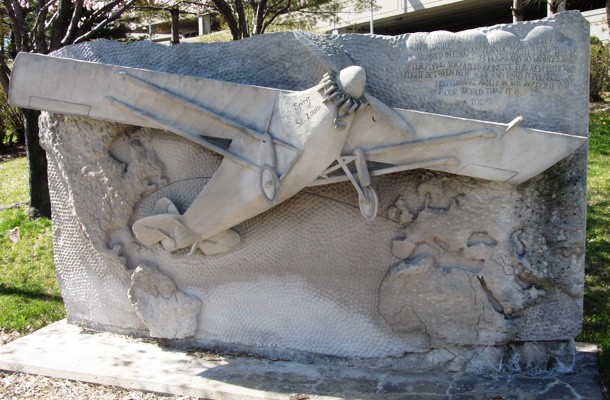Roosevelt Field and the Liftoff for Lindbergh's Spirit of St. Louis Monument
Introduction
Text-to-speech Audio
Roosevelt Field is home to one of the largest shopping malls in the United States, but prior to the postwar period, this land was part of an airfield and the site of aviation history. Charles Lindbergh began his transatlantic flight from this location in 1927. Lindbergh, then just twenty-five years old, was the first person to fly solo and nonstop across the Atlantic. After thirty-three hours in the air, Lindbergh landed in Paris, on May 21, 1927, and became an instant celebrity for his successful flight. This airfield was also used by other famous aviators of the era, including Amelia Earhart. Prior to World War I, the airfield was known as Hempstead Plains Aerodrome until 1919 when it was named in honor of former President Teddy Roosevelt's son Quentin, a combat aviator who perished in World War I. Roosevelt Field was used as an airport until the 1950s. Since that time, the property has been used for shopping centers, including the Roosevelt Field Mall.
Images
Charles Lindbergh

Lindbergh's take off from Roosevelt Field

The crowd in Paris when Lindbergh landed

This sculpture is reportedly located at the place where Lindbergh's plane became airborne ahead of his historic 33-hour flight.

Backstory and Context
Text-to-speech Audio
Charles Lindbergh became an instant celebrity in 1927 when he made the first solo, nonstop transatlantic flight. His historic flight originated at Roosevelt Field on Long Island, an airfield that played an important part in aviation history on numerous occasions.
Lindbergh developed an interest in aviation as a child. In 1911, when he was just a boy, Lindbergh heard the sound of an engine above his family's home. He ran to the window and saw an airplane--then still something of a novelty. From that point on, Lindbergh was consumed with learning to fly, although it would be a number of years before he encountered a plane again. In 1922, after dropping out of college, Lindbergh took his first flight as a passenger. Later that year, after seeing a demonstration of a parachute jump, that he decided to jump himself. For a moment he believed his fate was sealed when one of his parachutes failed to open. After his backup parachute deployed and he returned safely to the ground, Lindbergh decided that if despite the dangers of experiencing flight, if he could have ten years of flying--even if he ultimately died in an accident--the decision would be worth it.
Less than a year later, Lindbergh purchased his first plane with help from his father. At the time, he'd never had a lesson. On the day he bought the plane, he completed a few hours of training with another pilot and made his first solo flight the same day. He joined the Army in 1924 but because the Army didn't need more pilots at the time, he returned to civilian life and began working as an airmail pilot.
In 1926, Lindbergh decided to compete for the Orteig Prize. The competition would award $25,000 to the first person to fly nonstop from New York to Paris, a feat that Lindbergh believed was less dangerous than flying airmail in winter conditions. At the time, however, most planes were not equipped to carry the necessary amount of fuel for a nonstop transatlantic flight. With the financial backing of several St. Louis businessmen, Lindbergh decides to design a plane capable of making the flight. The result--a plane he named the Spirit of St. Louis--was built with extra fuel tanks, as well as a longer fuselage, longer wingspan, and extra struts to accommodate the weight of the extra fuel. In preparation for the flight, Lindbergh made 23 test flights on the Spirit of St. Louis.
Lindbergh's historic flight took place on May 20, 1927 from Roosevelt Field. Lindbergh, just 25 years old at the time, left the plane's side windows open so that the cold air would help keep him awake. At times during the flight, he held his eyelids open with his fingers and would later recall hallucinating that ghosts were moving in and out of the cockpit. After more than 33 hours in the air (and more than 55 hours awake), Lindbergh landed in Paris, making history and becoming an immediate sensation on both sides of the Atlantic. A crowd of roughly 150,000 greeted him when he landed in France.
Despite Roosevelt Field's importance to aviation history, it closed shortly after World War II. After the airfield closed, developers purchased it and began building a shopping center on the site. Today, the site of one of history's most important flights is home to Roosevelt Field Mall, one of the country's largest malls.
Sources
Cohen, L. S. . Five Times Long Island Made Aviation History , Long Island . November 9th 2019. Accessed June 12th 2021. https://www.longisland.com/news/11-09-19/five-times-long-island-made-aviation-history.html.
Cohen, L. S. . This Day in Long Island History: Lindbergh Completes his Famous Flight from Long Island to Paris , Long Island . May 21st 2020. Accessed June 12th 2021. https://www.longisland.com/news/05-21-20/this-day-in-long-island-history-lindbergh-completes-his-famous-flight-from-long-island-to-paris.html.
Timeline, Minnesota Historical Society . Accessed June 12th 2021. https://www.mnhs.org/lindbergh/learn/timeline.
Alba, Joseph . Long Island's Roosevelt Field , Metro Airport News . January 10th 2020. Accessed June 12th 2021. https://metroairportnews.com/long-islands-roosevelt-field/.
https://www.longislandpress.com/2013/05/02/charles-lindbergh-long-islands-lucky-loner/
